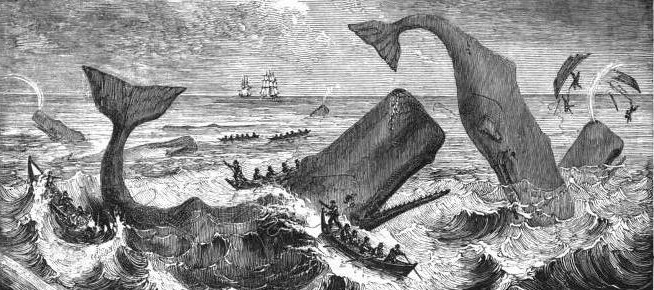9/30/21, 9:01pm
33
After a walk to take in the streets of New Bedford, Ishmael sallies out a second time for a special visit to the city’s famed “Whaleman’s Chapel.” Upon entering the place, he notes as many “sailor’s wives and widows” as sailors among the small, scattered congregation. Each of the congregants appears isolated in an experience of grief. Ishmael notes their sense of loss as a matter of fact, as palpable to his eyes as as their “muffled silence” to his ears.
To illustrate this grieving archipelago MK arranges three of his white peglike figures along the lower margin of the canvas with only their heads exposed. Like the water gazers in 2 each of them faces a different direction, one left, one right, one forward. Unlike the water gazers, however, whose lidless, hazy eyes stare in every direction but landward, the grievers’ eyes are all drawn passively closed like the dreamer in 15. The two peglike figures turned profile have large individual teardrops dangling like jewels from the drape-lines of their eyes. Previously, I extemporized that the water gazers were magnetically drawn to the water in proportion to how sealed off they are from it, like buoys. The extremity of grief lodged in the Whaleman’s Chapel – that specially unresolveable grief specially reserved for the “placelessly perished” – draws water from the driest of dowels.
The isolated griefs are minimized by the features of the canvas dedicated to MK’s rendering of the space of Whaleman’s Chapel itself. The 8×9 inch found page is occupied almost entirely by a closeup black-and-white photo of a section of brick wall, marred and uneven in its finish and adjoining what appears to be an industrial weather-sealed concrete surfacing, dark in color. On the fifth brick down from the topmost brick in the frame, the words “I need” are chalked in an informal cursive. The seven bricks below this one are void of writing as the ones above it, but the words scrawled on the fifth brick leave you projecting on the bricks below, above, and all around – like a spreadsheet – various scrolling lists of nouns and verbs and prepositional phrases that would answer to “I need…” In front of the original street art in the photograph, before the chalk washed away, you’d have the whole wall.
That is, if you look past the painting that forms the canvas’s foreground. On level with where the grieving pegheads enter the frame so too does a towering cross extending halfway up the height of canvas, formed of broad, partially transparent canary yellow brush strokes, dotted over with 9 daubs of opaque white paint, up and across, crossing at the third and fifth dot respectively. Over the upper third of the found page, irrespective of the cropped photograph of the brick wall, are capital letters formed not by lines but individual semi-opaque daubs of yellow spelling the name JESUS.
In MD the scattered silent islands of people assembled in the Whaleman’s Chapel all gaze upon marble tablets engraved with the names of the placelessly perished, drawing their eyes toward the walls of the space that contains their respective insular and incommunicable griefs as a congregation. The heads of MK’s peg people are all turned away from the wall. In fact, they’re painted on a plane and a scale that defies the margin of the wall’s appearance, as the name above them is spelled across that margin: a constellation of isolated dots, taken from a cross and put up on high. Sometimes there’s no faith but for that of a space. Never is there space but for that of a faith.

MOBY-DICK, Page 033
Title: Each silent worshipper seemed purposely sitting apart from the other, as if each silent grief were insular and incommunicable.
(8 inches by 9 inches; acrylic paint and ink on found paper; September 7, 2009)
